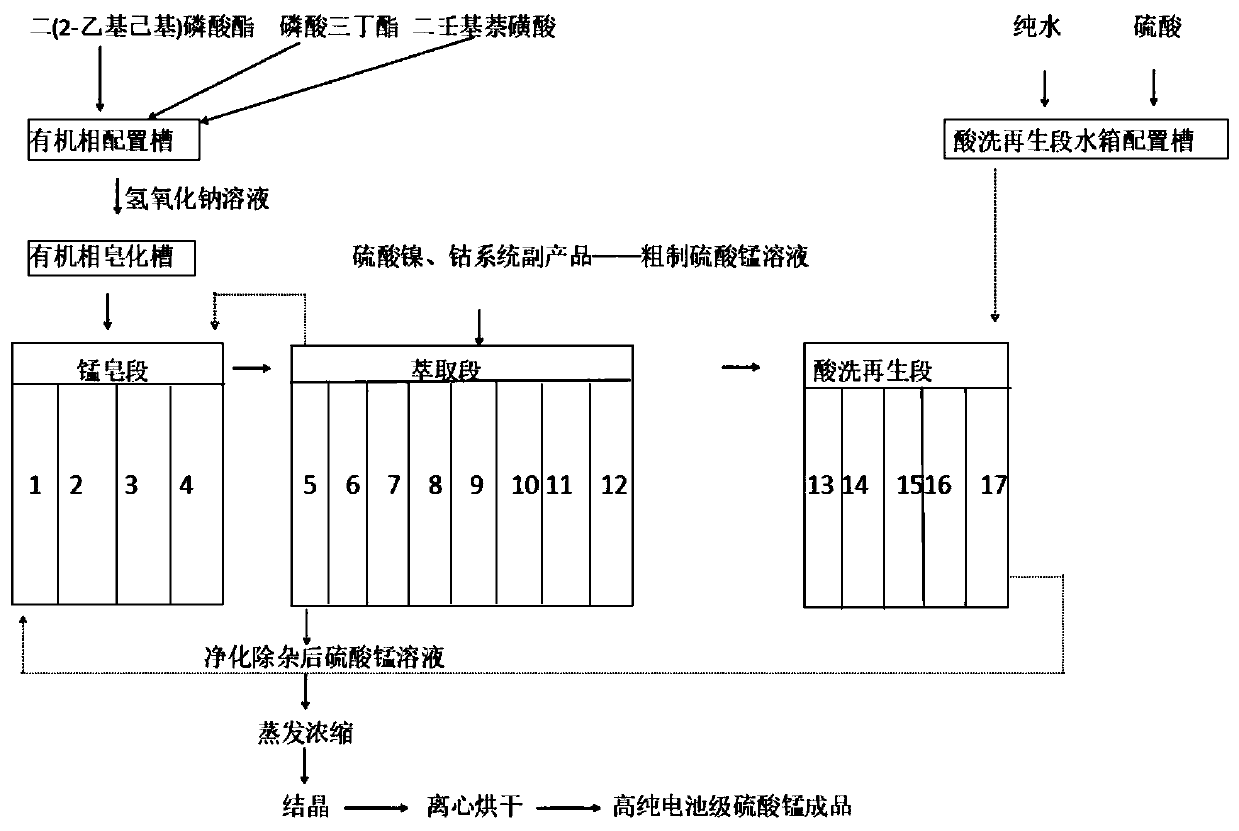Method for removing zinc, calcium and magnesium ions in manganese sulfate solution by synergistic extraction method
A manganese sulfate solution and extraction technology, which is applied in the field of hydrometallurgy, can solve the problems such as the inability of the extractant to be recycled for a long time, the high water solubility of the extractant, the residual fluoride ion, etc., so as to save energy and auxiliary materials, and reduce the water solubility. , the effect of less consumption
- Summary
- Abstract
- Description
- Claims
- Application Information
AI Technical Summary
Problems solved by technology
Method used
Image
Examples
Embodiment 1
[0023] The method for removing zinc, calcium and magnesium ions in manganese sulfate solution by cooperative extraction is characterized in that, comprising the following steps:
[0024] Step 1. According to the weight ratio of di(2-ethylhexyl) phosphate, tributyl phosphate and dinonyl naphthalene sulfonic acid, the extractant is configured in a ratio of 5:2:3, and the volume ratio of extractant to sulfonated kerosene is Adding sulfonated kerosene to the extractant at a ratio of 3:7 is configured as an organic phase with an extractant concentration of 30%; the crude manganese sulfate solution is the water phase; the pH of the crude manganese sulfate solution is 2.0, and the crude The content of each element in the manganese sulfate solution is manganese 115g / L, iron 0.0008g / L, zinc 8.55g / L, calcium 0.3g / L, magnesium 0.005g / L, nickel 0.003g / L, sodium 0.005g / L;
[0025] Step 2, adding the organic phase configured in step 1 into a sodium hydroxide solution with a concentration of...
Embodiment 2
[0032] The method for removing zinc, calcium and magnesium ions in manganese sulfate solution by cooperative extraction is characterized in that, comprising the following steps:
[0033] Step 1. According to the weight ratio of di(2-ethylhexyl) phosphate, tributyl phosphate and dinonyl naphthalene sulfonic acid, the extractant is configured in a ratio of 5:1.5:3.5, and the volume ratio of extractant to sulfonated kerosene is Adding sulfonated kerosene into the extractant at a ratio of 3:7 is configured as an organic phase with an extractant concentration of 30%; the crude manganese sulfate solution is the water phase; the pH of the crude manganese sulfate solution is 1.7, and the crude The content of each element in the manganese sulfate solution is manganese 122g / L, iron 0.0009g / L, zinc 8.13g / L, calcium 0.26g / L, magnesium 0.003g / L, nickel 0.004g / L, sodium 0.001g / L;
[0034] Step 2, adding the organic phase configured in step 1 into a sodium hydroxide solution with a concentra...
Embodiment 3
[0041] The method for removing zinc, calcium and magnesium ions in manganese sulfate solution by cooperative extraction is characterized in that, comprising the following steps:
[0042] Step 1. According to the weight ratio of di(2-ethylhexyl) phosphate, tributyl phosphate and dinonyl naphthalene sulfonic acid, the extractant is configured in a ratio of 5:1.5:3.5, and the volume ratio of extractant to sulfonated kerosene is Adding sulfonated kerosene into the extractant at a ratio of 2:8 is configured as an organic phase with an extractant concentration of 20%; the crude manganese sulfate solution is the water phase; the pH of the crude manganese sulfate solution is 2.5, and the crude The content of each element in the manganese sulfate solution is manganese 95g / L, iron 0.0003g / L, zinc 9.71g / L, calcium 0.20g / L, magnesium 0.005g / L, nickel 0.002g / L, sodium 0.001g / L;
[0043] Step 2, adding the organic phase configured in step 1 to a sodium hydroxide solution with a concentratio...
PUM
| Property | Measurement | Unit |
|---|---|---|
| Acidity | aaaaa | aaaaa |
| Acidity | aaaaa | aaaaa |
| Acidity | aaaaa | aaaaa |
Abstract
Description
Claims
Application Information
 Login to View More
Login to View More - R&D
- Intellectual Property
- Life Sciences
- Materials
- Tech Scout
- Unparalleled Data Quality
- Higher Quality Content
- 60% Fewer Hallucinations
Browse by: Latest US Patents, China's latest patents, Technical Efficacy Thesaurus, Application Domain, Technology Topic, Popular Technical Reports.
© 2025 PatSnap. All rights reserved.Legal|Privacy policy|Modern Slavery Act Transparency Statement|Sitemap|About US| Contact US: help@patsnap.com

